
The plan YPF presented to export 40 billion dollars annually
The plan is structured around four pillars, under the slogan of '4x4.'
The Investor Day toward 2030 that Horacio Marín, the CEO of YPF, presented in New York represents a significant turning point, a milestone that marks a turning point not only for the company itself but for the entire hydrocarbon sector in Argentina.
The plan is structured around four pillars, under the slogan of "4x4." The first proposes a different management model, completely focused on efficiency and with a strong technological component. Concrete results are already being seen thanks to tools like the Real Time Intelligence Centers applied to both upstream and downstream.
The second pillar, currently in execution, aims to concentrate YPF's operations on the most profitable assets: Vaca Muerta. This implies active portfolio management—which allows for the buying and selling of shale areas—and a progressive withdrawal from conventional fields.
The other two axes, although not explicitly listed in the company's Excel charts, are strategic: oil and gas exports. Regarding oil, the construction of the megaproject Vaca Muerta Oil Sur (VMOS) is already underway, which includes a pipeline and a port in Río Negro. It is expected that by the end of the year, shipments will begin to depart from there on the largest ships in the world.

In this regard, YPF confirmed that an agreement was reached with the government of Río Negro, which had halted the work demanding a special contribution. Finally, a payment was established that could reach 50 million dollars over a period of 10 years.
The fourth axis, the most relevant in economic terms, is Liquefied Natural Gas (LNG). YPF estimates that, starting in 2030, this sector will generate, along with its partners, exports of about 40 billion dollars annually. The Argentina LNG project is advancing steadily and includes three phases.
The initial stage is being executed by Southern Energy, an alliance between Argentine gas producers, born from the partnership between Pan American Energy (PAE) and the Norwegian Golar.
The initiative plans for the installation of two liquefaction vessels on the coast of Río Negro, in the area of Fuerte Argentino—south of Las Grutas—with the capacity to export up to 6 million metric tons annually (MTPA) of LNG.

Horacio Marín's words
"All services and materials need to be considered, look at the sand, the routes, which is something that the governor of Neuquén and (the head of Private Oil Workers, Marcelo) Rucci always told me that there's a lack of infrastructure. All those things need to be thought about, and you can't expect the State to do them," Marín pointed out.
In that sense, he emphasized: "it's a mistake to wait for the State because the ones who have the drive and the means to do it and the capital are the companies."
The CEO of YPF stressed that "this is the great work ahead and the most difficult. Because the Vaca Muerta Institute, for me, it's unbelievable that the companies haven't signed it because it costs nothing, and I can't believe that when they later talk about security, they delay the entry."
Marin highlighted that "if you see today what the industry spends on vans, I did the math and I'm not crazy. It needs to be analyzed, in an activity that's going to double or more, if it's not better to make a passenger train and reduce the load on the roads."
With an ambitious expansion goal ahead, Marin emphasized that "this is the most difficult part because it doesn't depend on the decision of a single company, but we have to do it among all of us who have assets in Vaca Muerta, plus the provincial governments and with the support of the unions. It's the most difficult part because we have to work among peers without a leader to decide, but I'm positive it will be achieved."
More posts: